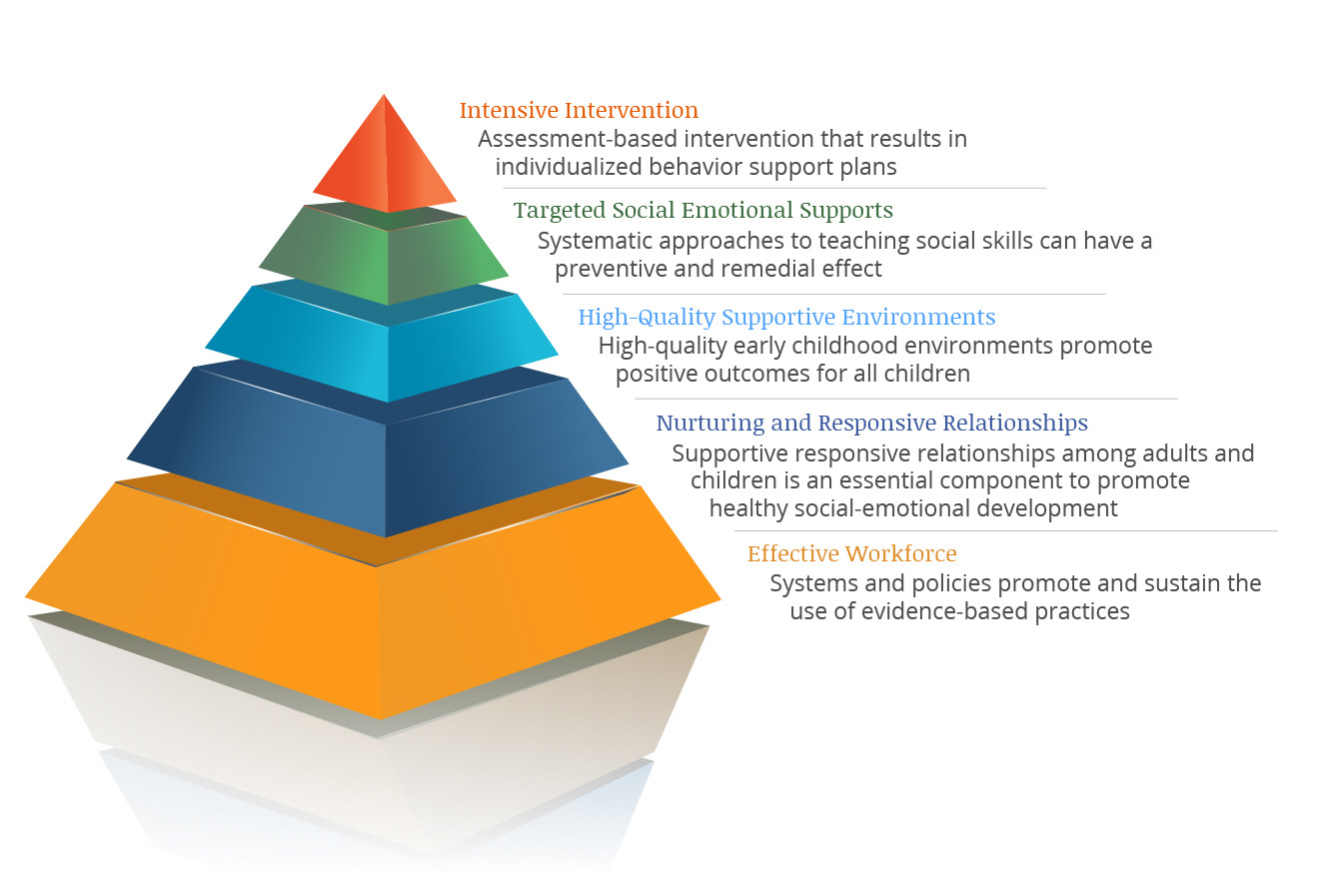- Define positive guidance.
- Describe why positive guidance is important for your program.
- Identify frameworks for positive guidance.
Learn
Teach
Take a minute, close your eyes, and think of an influential adult from your childhood. How did this person help guide you to make good choices? How did they express encouragement when you made a mistake? How did this make you feel overall? Contrast this with an adult who focused primarily on your misbehavior and mistakes. What did they say or do to express disapproval? How did this influence your behavior and feelings toward yourself, that particular adult, and adults in general?
The adults you work with have encountered a range of life experiences that have shaped and continue to define the individuals they are today. These experiences influence how they interact with and provide guidance to other adults and children. As a trainer or coach, it is your responsibility to make sure all staff members understand how to positively influence the behavior of children through appropriate and positive guidance.
Why Do Children Engage in Challenging Behavior?
There are many reasons why children might engage in behavior that adults find challenging. Sometimes challenging behavior is part of typical development. In all cases, a child’s behavior communicates a message. It is up to adults to learn the child’s “code” and interpret the message. Here are some messages a child’s behavior might send:
- I need your attention, but I don’t know how to ask for it.
- I don’t know what I’m supposed to do.
- I need help.
- I’m bored.
- I’m lonely.
- I don’t feel well.
- I’m scared.
- I’m tired.
- I don’t want to do that, or I don’t like that.
- I’m overwhelmed.
What is Guidance?
Guidance is the way staff members help children know what it means to be members of your community. It is how they help children learn the expectations for behavior in a variety of settings. It means helping children learn from their mistakes and make positive choices.
You must also teach staff members what guidance is not. Guidance is not punishment. It is not about control or making children fear adults. Guidance involves knowing children and creating the best physical and social environment in which they can learn; it is proactive rather than reactive.
As we think about positive guidance practices, we can refer to the Pyramid Model to illustrate the components of a high-quality approach to positive behavior supports for children and youth.

Pyramid Model: Understanding Proactive Approaches to Guidance
Positive guidance can help build important social, emotional, and life skills. The children in your program are the next generation of our country, and it is important that children understand how to function civilly in a modern and complex democratic society. Dan Gartrell, author of Education for a Civil Society, suggests the following five essential skills, which he calls democratic life skills:
- Finding acceptance as a member of a group and as a worthy individual
- Expressing strong emotions in non-hurting ways
- Solving problems creatively—either independently or in cooperation with others
- Accepting unique human qualities in others
- Thinking intelligently and ethically
Applying democratic life skills can help to ensure the long- and short-term decisions we make are moving us in the right direction. However, this can be challenging to remember when in the midst of a stressful situation involving a child or another adult. It is important to remember who owns the problem and what we can and cannot control. We have no control over the ways others choose to treat us. We do, however, have control over how we react to the actions of others.
A proactive response to challenging behavior relies on guidance to teach the child the skills they may be missing. According to Hearron & Hildebrand (2013), guidance can be defined as:
- Words and actions that positively influence the behaviors of others
- Establishing appropriate expectations and supporting others so that they do the right thing
- Providing ample opportunities for practice and success
- Remaining helpful and encouraging when mistakes occur
- Understanding your own values while respecting the values of others
Gartrell (2004), in The Power of Guidance, describes six practices of teachers who are committed to positive guidance:
| Practice | Implementation Process |
|---|---|
| Children are learning socially acceptable behavior, and it takes time and practice to develop social skills. Families and teachers guide children to learn social skills. |
| The teacher uses developmentally appropriate practices in order to have an appropriate match between the program’s expectations and the child’s skills. |
| The teacher builds relationships with each individual child and models cooperation and empathy. |
| The teacher models how to resolve conflicts peaceably and encourages children to negotiate for themselves. The teacher works at managing and monitoring his or her own feelings and growth as a developing professional. |
| From the time the child enters the program, the teacher builds positive relationships with family members through positive notes, phone calls, meetings and conferences. |
| The teacher understands that she or he cannot do everything alone and creates a team with other adults (including family members and volunteers). Positive guidance involves teamwork with other skilled adults, especially if a child has consistent, intensive challenging behavior. |
Impact of Culture and Experience on Guidance
Consider a few examples of how beliefs and experiences shape adult expectations of children: There are multiple factors that can influence how adults respond to a child’s behavior, including how the adults were raised, their personal values and beliefs, and their understanding of child development. Through careful examination of these factors, you can improve interactions between staff members and children. This will positively influence the social and emotional development of the children you serve. Consider a few examples of how beliefs and experiences shape adult expectations of children:
- The age at which a child feeds or dresses herself or himself
- The age at which a child uses the toilet independently
- Whether and when a child sleeps independently
- The amount and nature of eye contact between children and adults
- Expectations for how adults and children talk to one another (e.g., acceptability of questioning adults, talking over one another, etc.)
- The amount of time infants spend being held or swaddled
- The age at which romantic relationships are acceptable for school-age children
- The nature of interactions between males and females
- The ways adults and children show affection (hugging, etc.)
A mismatch between our own expectations and a child’s behavior (or family’s priorities) may cause tension. It is important to understand the variability in behaviors that might be influenced by our beliefs and experiences. You can also help them reflect on the way their own upbringing influences their view of child guidance. For example, a staff member whose family members used corporal punishment may think physical responses are acceptable or desirable. A staff member who grew up in a strict home may view guidance very differently from a staff member who grew up in a home with few rules. A staff member’s own upbringing may influence the kinds of behaviors they tolerate. Consider these different responses to the same situation:
Situation: Jeremy, a child in the preschool classroom, gets up and leaves a group activity without permission.

Carl, Sylvia, and Kat’s responses are not right or wrong; they are simply different representations of how beliefs and experiences have shaped their approaches to guiding behavior. Your role is to understand these differences and to help staff members respond in ways that are consistent with your program’s guidance philosophy.

Sylvia thinks Jeremy is expressing his independence and making a choice. She continues on with the group activity without acknowledging that Jeremy left the group.

Kat thinks the topic of discussion reminded Jeremy of his mom who is deployed. Kat thinks Jeremy needs a bit of space and asks another adult to check on and comfort him.
Carl, Sylvia, and Kat’s responses are not right or wrong; they are simply different representations of how culture and experiences have shaped their approaches to guiding behavior. Your role is to understand these differences and to help staff members respond in ways that are consistent with your program’s guidance philosophy.
You also have an important opportunity to help staff members reflect on how their personal expectations and life experiences influence the way they interact with children—and even what they notice in the classroom or program. In the situations above, Carla may become frustrated with Jeremy. She may be more likely to view Jeremy’s other behaviors throughout the day as disobedience or defiance. This could create a pattern of negative interactions between Carla and Jeremy. Now imagine that Sylvia, from the scenario above, sees Jeremy’s behavior as an acceptable choice, but when another child leaves the group, she perceives the situation differently. She reprimands the second child for not following directions and participating in the group. This may reflect an inconsistency in expectations or perceptions of behavior.
It’s important to recognize that our attitudes, beliefs, and assumptions can influence our decisions and lead us to treat people differently—sometimes without even realizing it. These influences may be shaped by a variety of factors, including personal background, past experiences, or social expectations. In child care settings, where professionals make quick decisions throughout the day, these patterns can affect how children are treated. When left unexamined, these influences can harm relationships, affect trust, and result in unfair treatment of children.
Trauma and Child Guidance
Trauma is caused by painful events or experiences in a person’s life. It has a particularly harmful effect on young children’s developing brains, but it can impact children, families, and staff across their lifetimes. Trauma influences behavior and child guidance in countless ways. It affects how children, youth, and adults build relationships, show trust, and interpret the actions of others. A trauma-informed approach to child guidance emphasizes physical and emotional safety, predictability, relationship-building, choice, and responsiveness to each child’s background and experiences. Consider these examples of trauma-informed guidance practices (NCPMI, 2021):
- Greeting each child by their preferred name
- Providing comfortable spaces where 1-2 children or youth can rest and observe
- Asking permission before touching, hugging, or picking up a child
- Explaining changes in routines
- Teaching and encouraging children to talk about emotions
- Providing opportunities for families to make connections with other families
- Involving children in making choices
- Offering safe body education
- Allowing children to be greeted in the style of their choosing (fist bump, high 5, wave, hug)
- Knowing and using the language of the family
Observe
How Does Positive Guidance Look in Practice?
Trainers and coaches who promote positive guidance practices create an encouraging environment for all children and adults. One aspect of positive guidance is creating an environment that promotes positive behavior and minimizes the need for adults to spend time reacting to children’s challenging behavior. Positive guidance practices emphasize teaching problem-solving and friendship skills. They build children’s sense of belonging and membership in the program. In contrast, discipline, or using punishment to control children’s behavior, can be misused by adults with negative consequences for children’s growth and development.
When program staff value and use positive guidance practices, they support the development of an encouraging classroom. The encouraging classroom environment is a setting where adults guide children to express and meet their needs in acceptable, safe ways. The child is an accepted member of the community, where each child feels safe and secure. Children are not threatened with removal from the classroom community, and they are not publicly criticized. Children’s mistakes are seen as characteristics of typical development and viewed as opportunities to learn more appropriate behaviors. Partnerships formed with families and peers are supportive and encouraging. Conflicts are seen as part of living in a community where adults help children learn effective conflict-resolution strategies and teach problem-solving skills.
Watch this video to see the role you play in promoting positive guidance in your program.
Guidance: Training & Curriculum Specialist’s Role
Model
Guidance as a Strengths-Based Approach
A program focusing on guidance will approach behaviors as opportunities to problem-solve and teach. Children are encouraged to assume responsibility for their behavior, care about and get along with others, and contribute to the group (Hemmeter et al., 2021). A positive climate focuses on teamwork, cooperation, acceptance, and patience even when mistakes happen. When a team focuses on the positive traits of others, they are likely to see an increase in the occurrence of those positive behaviors.
What Does This Mean for You?
You provide the training and support for new staff members as they reflect on their own experiences, beliefs, and understanding of guidance. You must be prepared to help staff members (a) reflect on their own experiences and assumptions and (b) use strategies that are consistent with your program’s guidance philosophy. To do so, you must be familiar with your program’s guidance statement and the forms of guidance that are acceptable and unacceptable in your program. You must provide training to staff members around these topics, observe classrooms or programs, and provide support as staff members learn to use positive guidance approaches. Challenging behaviors are some of the most difficult issues staff members will address, so they need your support.
Completing This Course
For more information on what to expect in this course and a list of the accompanying Learn, Explore and Apply resources and activities offered throughout the lessons, visit the Training & Curriculum Specialist Positive Guidance Course Guide.
To support the professional development of the direct care staff members or family child care providers you oversee, you can access their corresponding Course Guides:
- Infant & Toddler Positive Guidance Course Guide
- Preschool Positive Guidance Course Guide
- School-Age Positive Guidance Course Guide
- Family Child Care Positive Guidance Course Guide
Explore
Take a few moments to think about what guidance means to you. What experiences have shaped how you think about child guidance? Respond to the questions in the Defining Guidance activity. Share your responses with a colleague or administrator. You can also complete this activity with staff members to start a conversation about guidance.
Apply
You can help staff members think about their own experiences and beliefs about child guidance. Beliefs About Guidance is an activity that can be used in a meeting with new staff or as staff development. The tool can spark conversation or reflection. Ask staff members to rate how strongly they agree or disagree with each statement. Use their responses to guide your coaching interactions when it comes to supporting staff with using positive guidance practices.
Glossary
Demonstrate
Afterschool Alliance (2018). An Ideal Opportunity: The role of afterschool in social-emotional learning. http://afterschoolalliance.org/documents/issue_sel_71.pdf
Berk, L. E. (2013). Child development (9th ed.). Upper Saddle River, NJ: Pearson Education Inc.
Collaborative for Academic, Social, and Emotional Learning (CASEL). https://casel.org
Cultivate Learning (n.d.). Circle time magazine big kids edition: Episode 2 social emotional learning. https://cultivatelearning.uw.edu/circle-time-magazine/season-4/
Denham, S. A., & Brown, C. (2010). Plays nice with others: Social-emotional learning and academic success. Early Education and Development, 21, 652-680.
Dombro, A.L., Jablon, J. & Stetson, C. (2020). Powerful Interactions: How to connect with children to extend their learning. 2nd ed. Washington, DC: NAEYC.
Derman-Sparks, L., & J Edwards. J.O., & Goins, C.M. (2020). Anti-Bias education for young children and ourselves.2nd ed. Washington, DC: NAEYC.
Dunlap, G., Wilson, K., Strain, P., & Lee, J. (2013). Prevent-teach-reinforce for young children. Paul H. Brookes.
Gartrell, D. (2004). The power of guidance. Clifton Park, NY: Delmar Learning.
Gartrell, D. (2012). Education for a civil society: How guidance teaches young children democratic life skills. National Association for the Education of Young Children.
Hearron, P. F., & Hildebrand, V. (2012). Guiding young children. Columbus, OH: Pearson.
Hemmeter, M.L., Ostrosky, M., & Fox, L. (2021). Unpacking the pyramid model: A practical guide for preschool teachers. Brookes Publishing.
Iruka, I., Curenton, S., & Durden, T. (2020). Don't look away: Embracing anti-bias classrooms. Gryphon House.
Marion, M. (2018). Guidance of young children. (10th ed.), Upper Saddle River, NJ: Pearson.
Massachusetts School-Age Coalition (n.d.). School-Age child guidance technical assistance paper. Dorchester, MA: MSAC. https://www.mass.gov/files/documents/2016/08/mo/child-guidance-school-age3.pdf
National Board for Professional Teaching Standards (2017). Early childhood generalist standards for teachers of students ages 3-8 (3rd ed.). https://www.nbpts.org/wp-content/uploads/2017/07/EC-GEN.pdf
National Center on Pyramid Model Innovations (NCPMI). (n.d.). National Center for Pyramid Model Innovations
National Center on Pyramid Model Innovations (2022). Equity coaching guide. https://challengingbehavior.cbcs.usf.edu/Implementation/Equity/Guide/index.html
Sandall, S., Hemmeter, M. L., Smith, B. S., & McLean, M. (2005). DEC recommended practices: A comprehensive guide. Longmont, CO: Sopris West.
Sandall, S. R., & Schwartz, I. S., Joseph, G., & Gauvreau, A. (2019). Building blocks for teaching preschoolers with special needs (2nd ed.). Baltimore, MD: Brookes.
Trawick-Smith, J. W. (2014). Early childhood development: A multicultural perspective (6th ed.). Upper Saddle River, NJ: Pearson Education Inc.
Whittaker, J. E. V., & Harden, B. J. (2010). Beyond ABC’s and 123’s: Enhancing teacher-child relationship quality to promote children’s behavioral development. NHSA Dialog, 13(3), 185-191.


